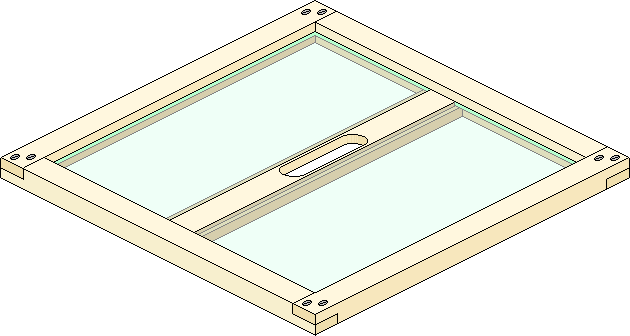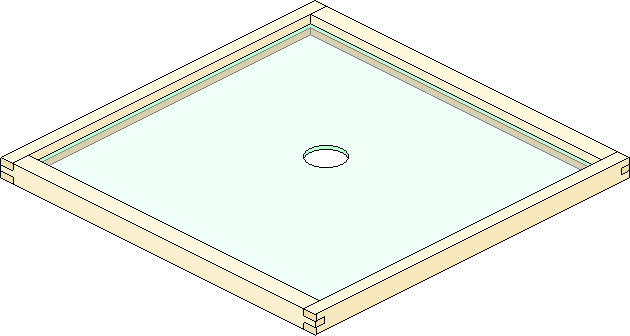Future Glass Boring Page
Perspex Version
|
|
|
|---|
|
Future Glass Boring Page Perspex Version |
Glass Quilt
|
|---|
This is depicted upside down for greater clarity.

The parts required, dimensions in mm, grain along longest dimension.
| Qty | Length | Width | Thickness | Material | Usage |
|---|---|---|---|---|---|
| 4 | 460 | 32 | 16 | pine | Rim (ends halved and inside grooved) |
| 1 | 406 | 50 | 10 | pine | Centre strut (rebated and pierced) |
| 2 | 406 | 184 | 4 | glass | Viewing panes |
Another version that is popular in the area that I live, has one single pane. (They were made locally by the Boone & Wright company. The basic design is given in more detail in the BIBBA leaflet number 12 of January 1973, written by John K. Mobley. This leaflet also gives some details of the John Cox bee escape that was intended to be used with this single pane arrangement.)

The parts required, dimensions in mm, grain along longest dimension.
| Qty | Length | Width | Thickness | Material | Usage |
|---|---|---|---|---|---|
| 2 | 460 | 19 | 16 | pine | Rim (ends tenoned and inside grooved) |
| 2 | 460 | 13 | 16 | pine | Rim (ends bridled and inside grooved) |
| 1 | 440 | 440 | 4 | glass | Viewing pane (with hole) |
The hole in the glass can be any thing between 25 mm and 32 mm in diameter and (a future page) covers the method of boring. The grooves should be 4.5 mm wide, 10 mm deep in the tenoned parts and 4 mm deep in the parts with the bridle ends (this allows square glass to be used). Durable assembly may be achieved by using 'no nails' glue without any other fasteners. Owing to the relatively thin rim parts they should be cut from straight grained knot free stock for strength.
Perspex or other Acrylic sheet is not a good substitute for glass in this particular design... The hole can be cut more easily, but the material sags and compromises the bee space, it also scratches easily and discolours. Surprisingly the glass is quite strong... I have never broken a glass one (I have only used them infrequently), but I have seen a broken Perspex one.
If top bee space is required, then Perspex can be utilised to good advantage.
Originated... 17-20 May 2002, Revised... 25 January 2003, Upgraded... 20 February 2006,
|